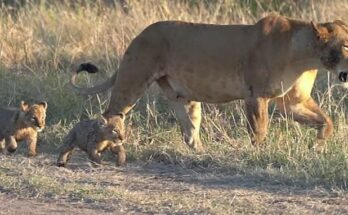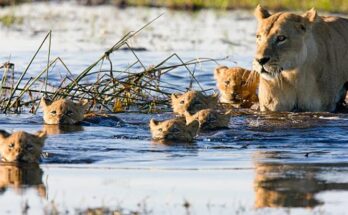
Lions are known for their laid-back lifestyle, spending up to twenty hours a day resting or sleeping. Despite their reputation as fierce predators, they are surprisingly inactive for most of the day. Their peak periods of activity usually occur after dusk, when cooler temperatures make it easier for them to move around and hunt. On average, lions spend just two hours each day walking—typically during these cooler times.
Recently, a beautiful pride of lions, made up of five lionesses and ten cubs of various ages, was spotted walking along the road near Ngotso, north of Satara Rest Camp in Kruger National Park. They created a natural roadblock, leisurely strolling for an extended period and preventing vehicles from passing. This behavior isn’t unusual for this pride; they’ve been seen using the roads in this area before.
Lions often prefer roads over bush paths because roads offer a smooth and unobstructed surface, which makes walking less strenuous, especially for cubs. Additionally, roads provide a better vantage point, allowing lions to spot prey or detect threats more easily than they could in the thick bush or tall grass. This strategic use of the road shows just how intelligent and adaptive these animals are.
In this pride, the lionesses typically take the lead when walking. They play a crucial role in protecting the cubs by scouting for danger ahead and ensuring the young ones stay in line. Their position at the front helps maintain order and safety, preventing curious cubs from straying into dangerous territory. Watching this structured, purposeful movement is not only a memorable sight but also a reminder of the strong social bonds and survival strategies that define lion behavior in the wild.


